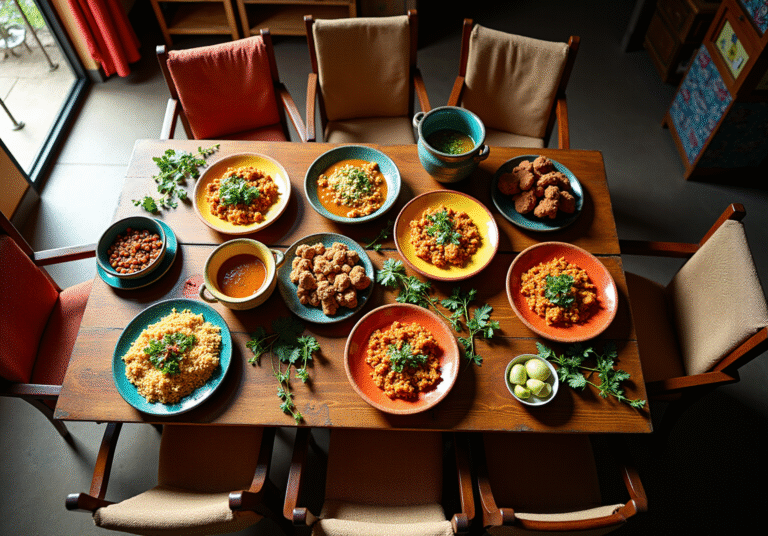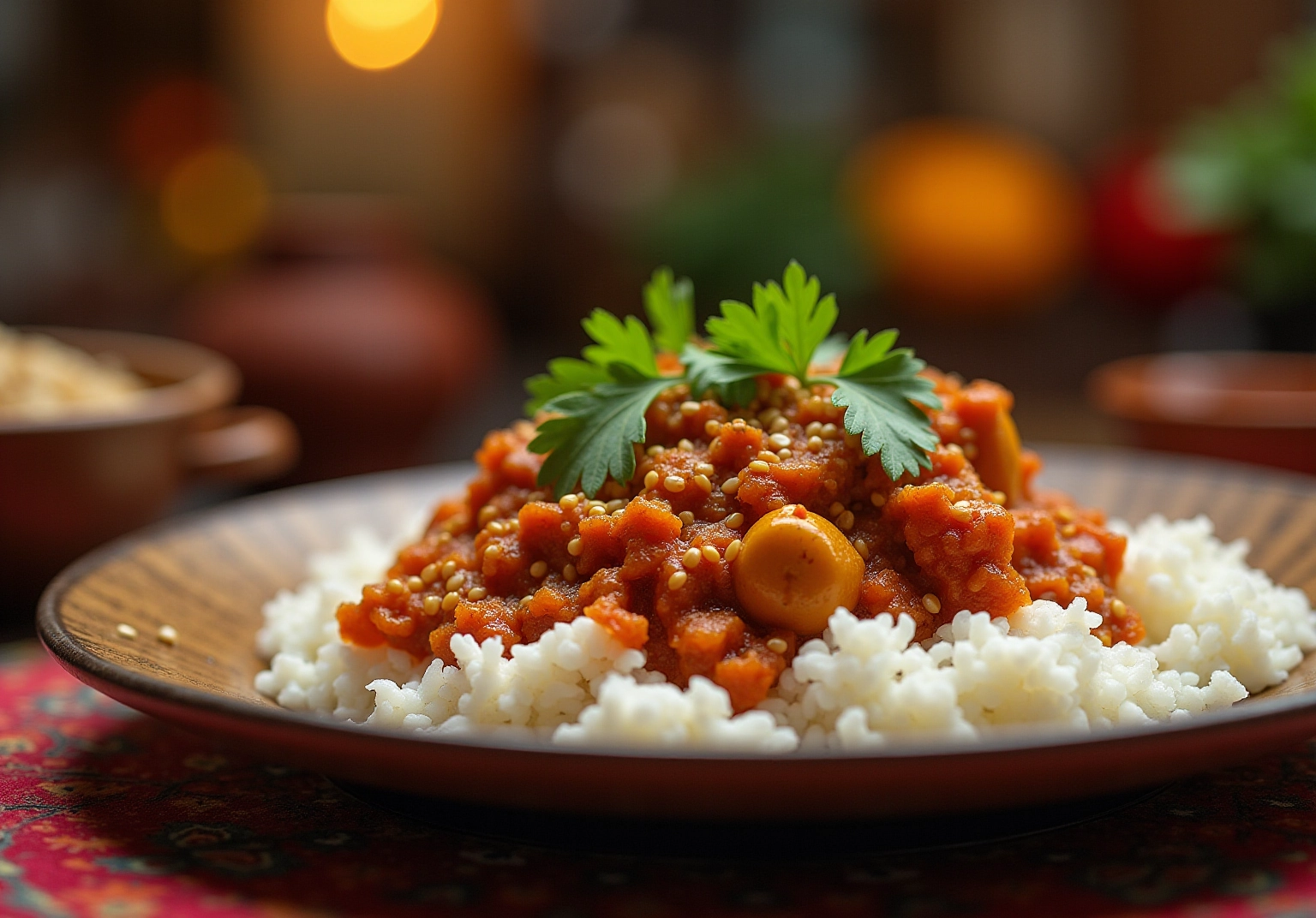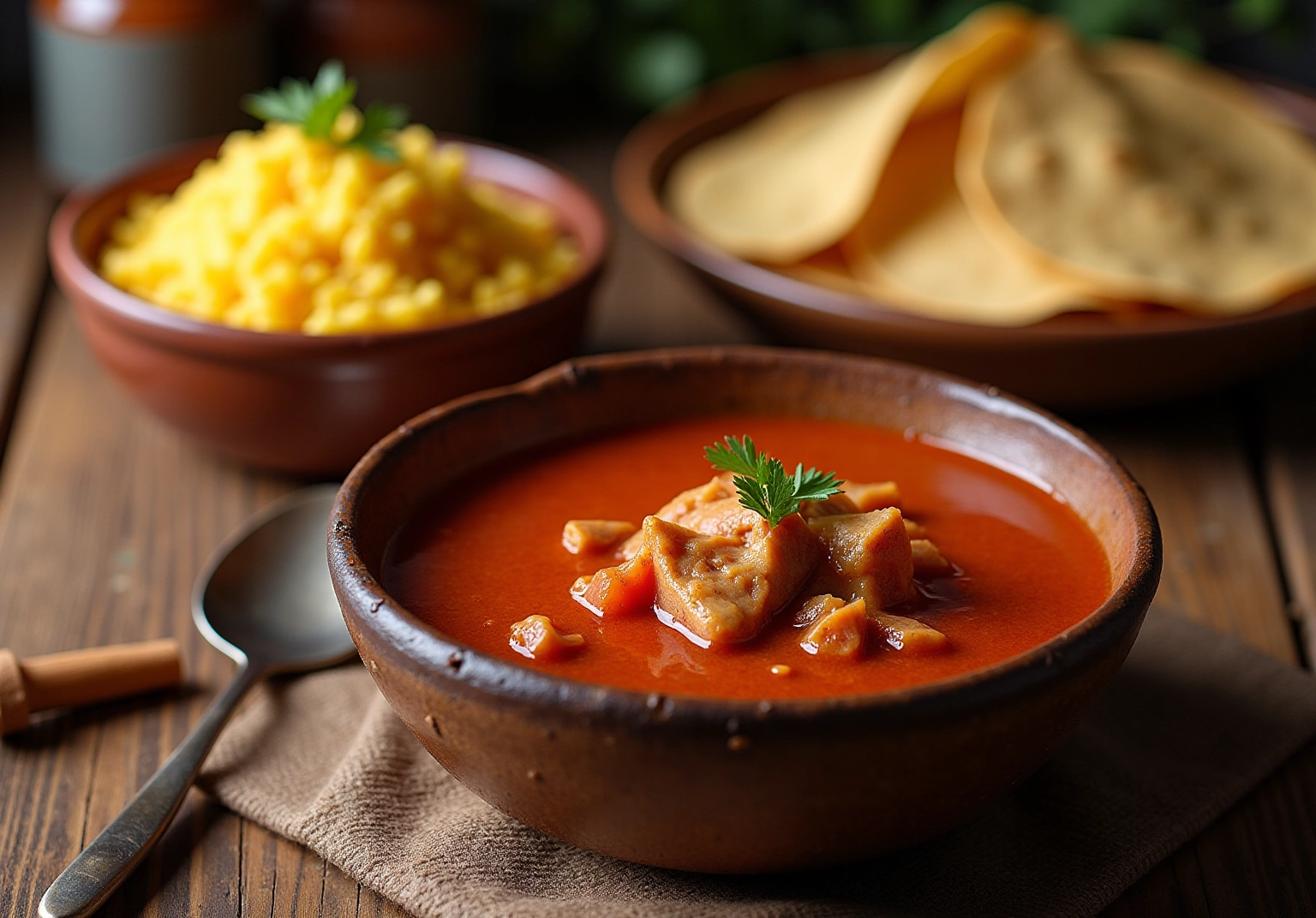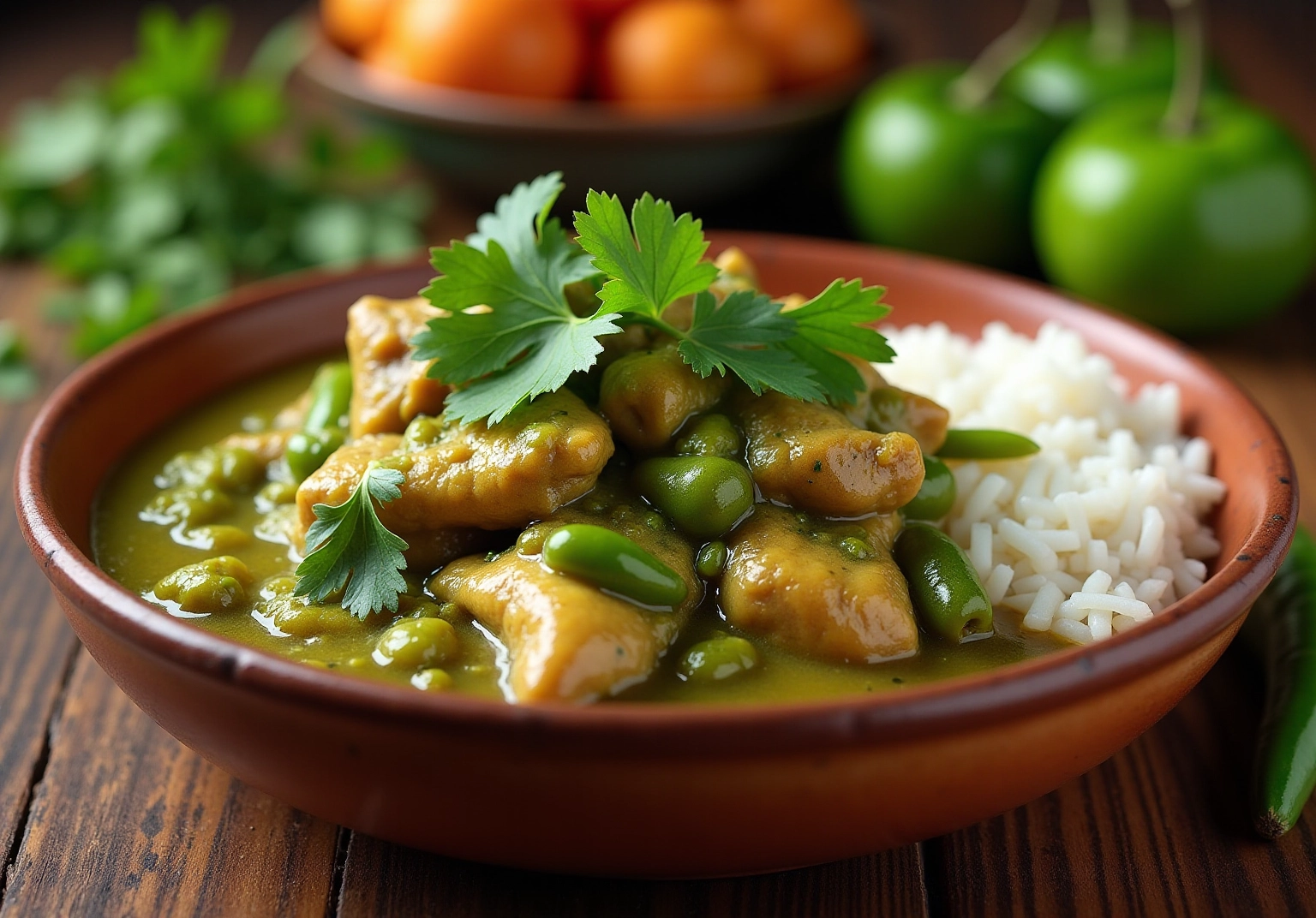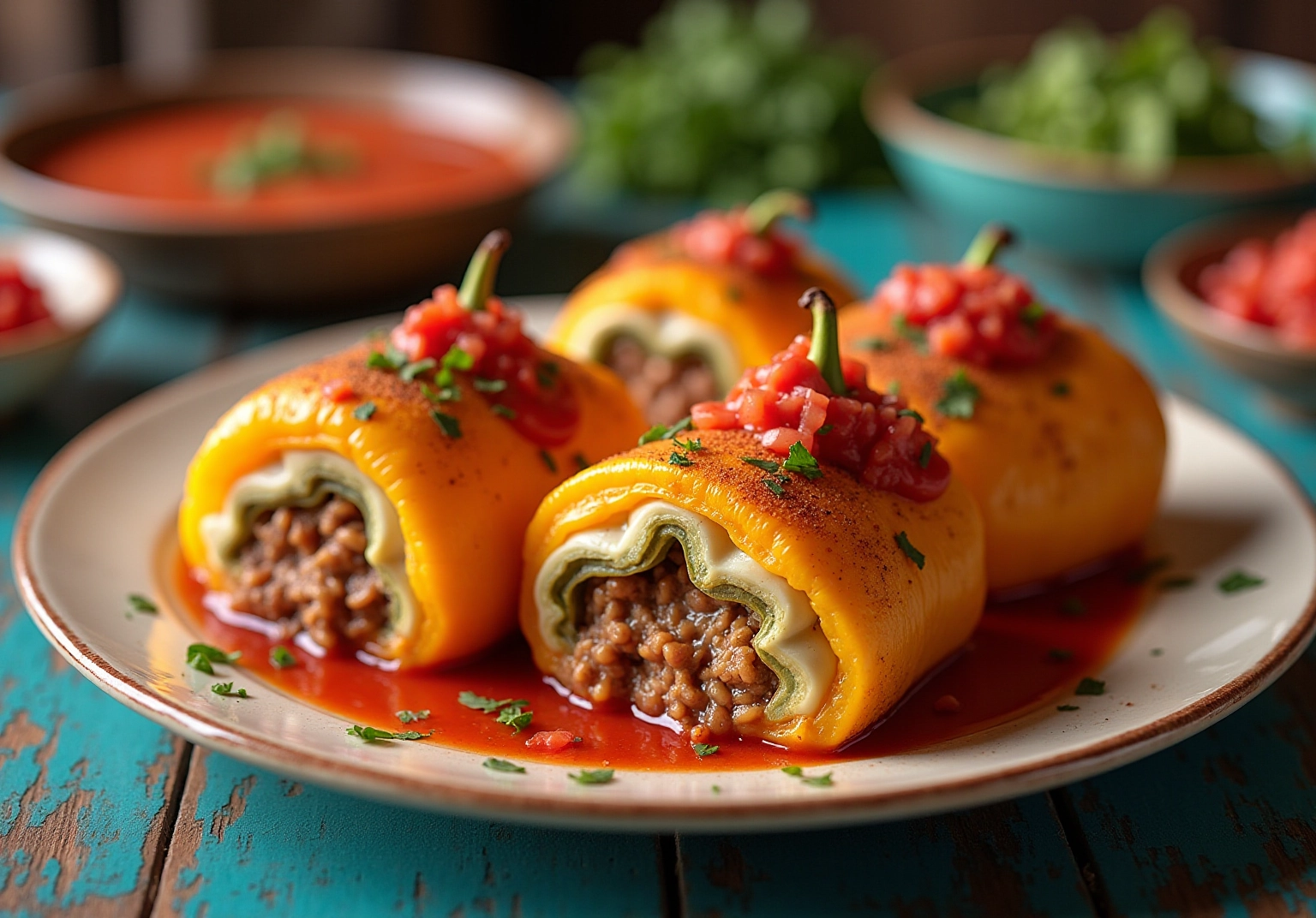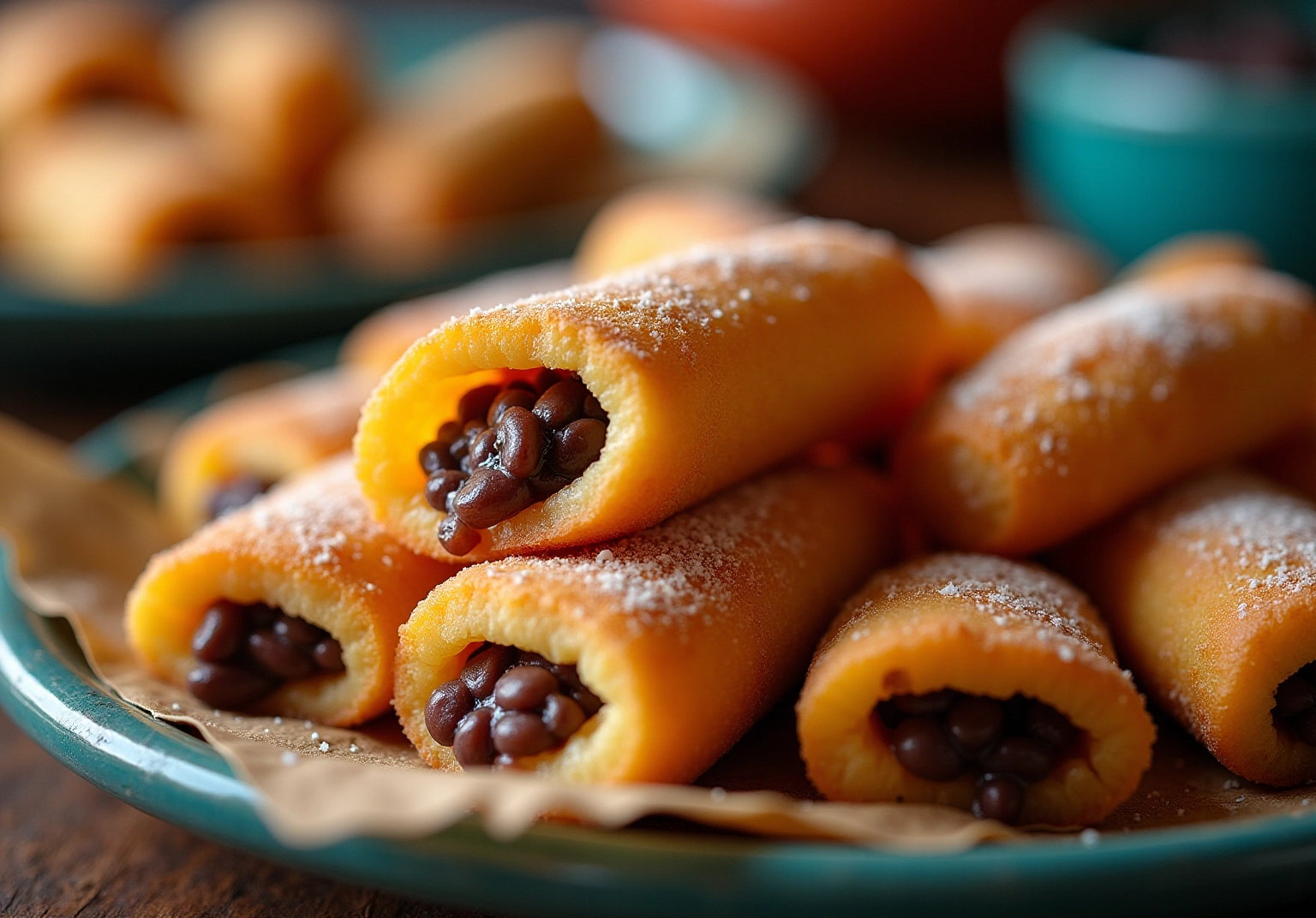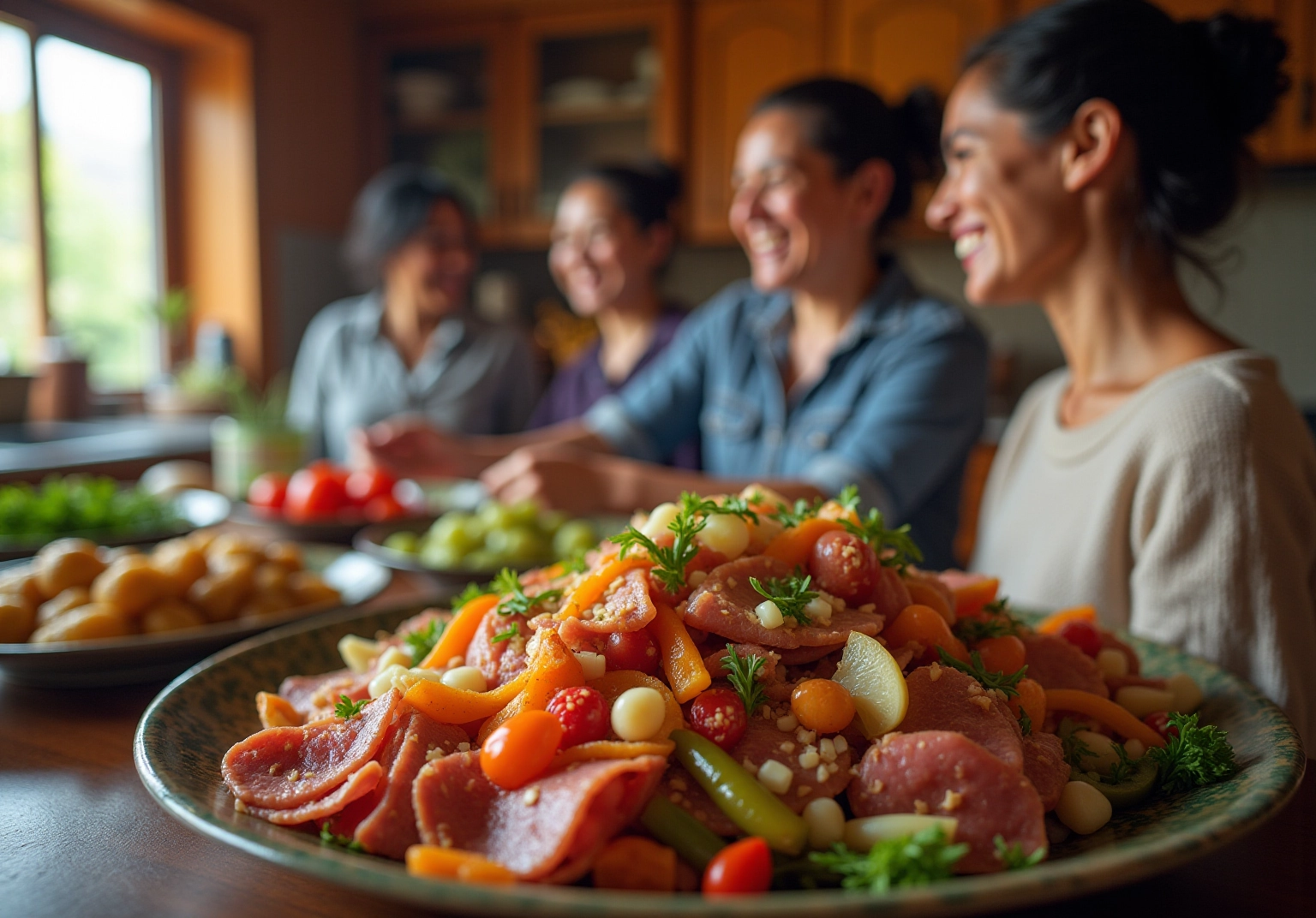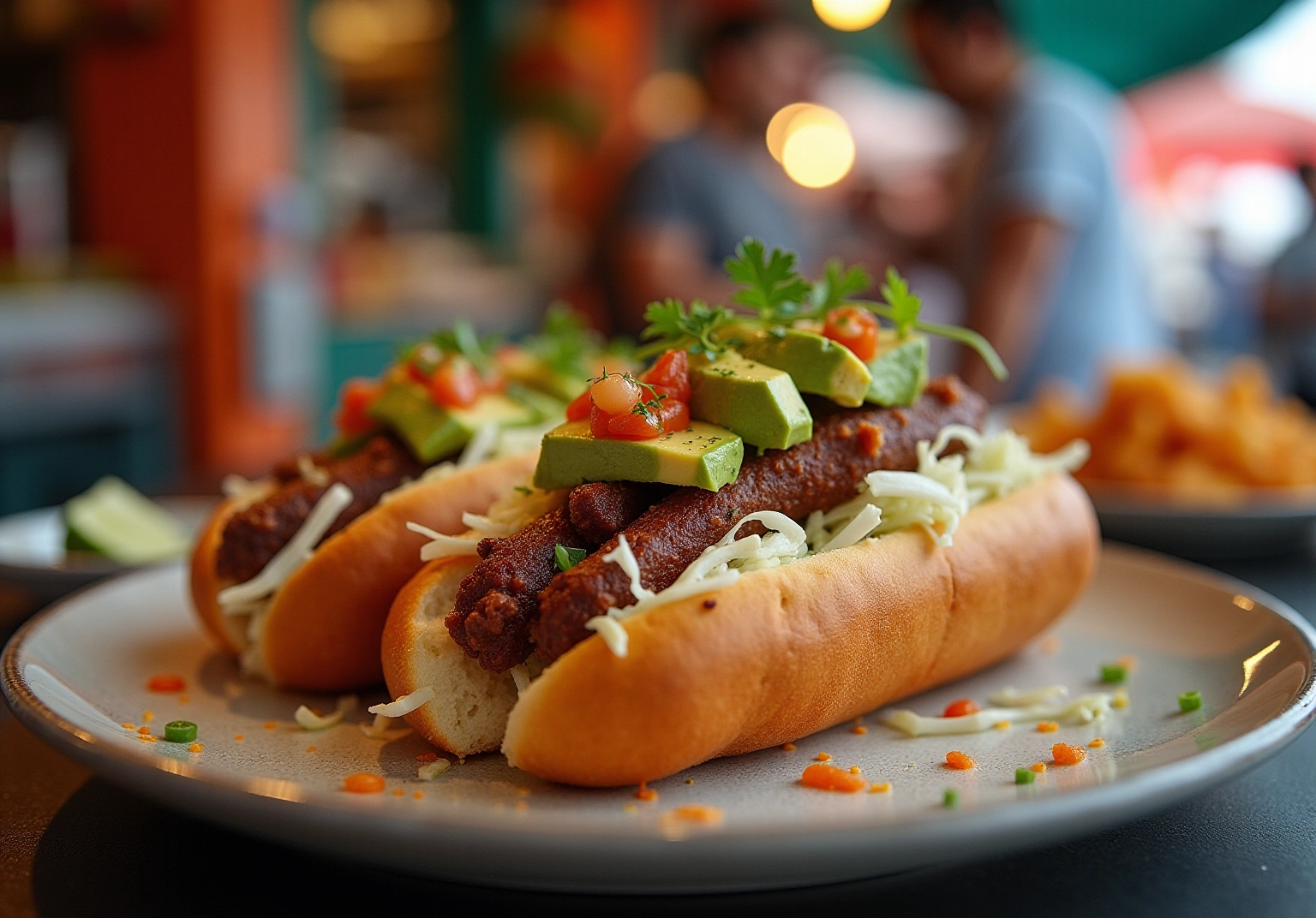Overview
Have you ever tasted the vibrant flavors of Guatemala? This article highlights ten famous Guatemalan dishes that are not just meals but a journey into the heart of the culture! From Pepián to Kak’ik and Jocón, each dish offers a delightful blend of indigenous and Spanish culinary influences. They don’t just tantalize your taste buds; they tell a story of Guatemala’s rich heritage. These meals play a vital role in communal gatherings and are key to preserving cultural traditions. So, let’s dive into this delicious adventure together!
Key Highlights:
- Guatemalan cuisine is characterized by vibrant flavors and cultural heritage, with each dish telling a unique story.
- Famous dishes like Pepián, Kak’ik, and Jocón showcase the blend of indigenous and Spanish culinary influences.
- Pepián, the national dish, is a hearty meat stew that reflects Guatemala’s rich food heritage and is often served during special occasions.
- Kak’ik is a traditional turkey soup that embodies cultural significance and is frequently featured in communal gatherings.
- Jocón is a chicken stew made with tomatillos, known for its vibrant green color and health benefits.
- Hilachas is a comforting shredded beef stew, emphasizing family recipes and regional variations.
- Chiles Rellenos are stuffed peppers that highlight versatility and creativity in Guatemalan cooking.
- Tamales are a cornerstone of Guatemalan tradition, symbolizing community and shared heritage during celebrations.
- Rellenitos de Plátano are sweet plantains stuffed with refried black beans, representing local food traditions.
- Fiambre is a colorful salad prepared for the Day of the Dead, symbolizing family heritage and remembrance.
- Shucos are flavorful street hot dogs that reflect the growing trend of street food culture in Guatemala.
Introduction
In the heart of Central America lies Guatemala, a country bursting with history, culture, and, most importantly, culinary delights! Guatemalan cuisine is like a vibrant tapestry, woven from indigenous traditions and Spanish influences. Each dish tells a unique story about its origins and the people behind it.
Imagine strolling through bustling markets filled with fresh ingredients or stepping into the warmth of family kitchens. The flavors of Guatemala invite you to embark on a gastronomic journey that goes beyond mere sustenance. As the world increasingly craves authentic experiences, dishes like Pepián, Kak’ik, and Jocón not only tantalize your taste buds but also create deep connections to the local culture and heritage.
Exploring Guatemalan cuisine reveals more than just food; it uncovers the rich cultural narratives and traditions that make each meal a true celebration of life and community. Are you ready to discover these delightful flavors?
The Design Tourist: Explore Authentic Guatemalan Cuisine
The Design Tourist invites you to dive into the vibrant world of famous Guatemalan dishes, where each dish tells a story rich with tradition and cultural heritage. Picture yourself wandering through lively markets and feeling the warmth of family kitchens—each flavor reflecting Guatemala’s rich history and diverse communities. This culinary journey not only tickles your taste buds but also deepens your travel experience, allowing you to forge meaningful connections with the local culture.
Imagine recipes that have been lovingly passed down through generations, linking modern cooking methods to ancestral roots. These famous Guatemalan dishes play a vital role in cultural tourism, showcasing the essence of Guatemala. Yet, it’s important to note that these culinary traditions face challenges. There’s an ongoing tension between the need for environmental protection and the socio-economic needs of the communities. As you seek authentic experiences, the famous Guatemalan dishes reflect the culinary traditions of Guatemala, offering a unique perspective on the artistry and stories behind each meal.
Karen LeBlanc emphasizes that every destination has a story to tell, and famous Guatemalan dishes are a delicious embodiment of its local culture. The evolving food market in Guatemala reflects current trends and the dynamic nature of its cuisine, making it an exciting destination for anyone eager to explore its rich gastronomic landscape.
Pepián: The National Dish of Guatemala
Pepián is a hearty meat stew that beautifully showcases one of the famous Guatemalan dishes and the rich food heritage of Guatemala! Imagine savoring tender chicken, beef, or pork, all brought to life with a vibrant mix of spices, vegetables, and a unique sauce crafted from roasted seeds and chilies. This beloved dish is one of the famous Guatemalan dishes and is typically served alongside rice and corn tortillas, making it a staple in many Guatemalan households. Did you know its roots trace back to the Mayan civilization? Over the centuries, Pepián has evolved, reflecting a delightful blend of indigenous and Spanish culinary influences.
Preparing Pepián is a meticulous yet rewarding process. You start by boiling the meat, then roasting key ingredients, and finally blending everything into a flavorful sauce. Not only does this meal tantalize your taste buds, but it also serves as a gateway to Guatemala’s rich history and cultural narratives. As culinary experts often say, enjoying famous Guatemalan dishes such as Pepián is like embarking on an immersive journey that connects you to the traditions and stories of the region!
In recent years, famous Guatemalan dishes like Pepián have become a favorite among tourists seeking authentic culinary experiences that resonate with local culture. Eateries that focus on famous Guatemalan dishes, such as traditional Pepián, have become essential stops for visitors eager to indulge in this national dish. Plus, the nutritional benefits of Pepián—packed with protein from the meat and essential nutrients from the vegetables and spices—only add to its charm.
Fun fact: the recipe for Pepián, one of the famous Guatemalan dishes, calls for about three liters of water when cooking the chicken, making it a practical choice for home cooks! Deeply embedded in Guatemalan culture, famous Guatemalan dishes like Pepián are often prepared for special occasions and family gatherings, symbolizing unity and tradition. Its historical significance is celebrated not just in homes but also at food festivals, where talented chefs showcase their unique interpretations of famous Guatemalan dishes, including this classic stew.
For a delightful serving of Pepián, imagine it atop a bed of fluffy white rice, garnished with fresh cilantro and sesame seeds to enhance both flavor and texture, as noted by expert Bert Hoover. And don’t forget to pair it with Buñuelos—sweet dough treats served in syrup with anise—highlighting one of the famous Guatemalan dishes that offer a glimpse into the broader spectrum of the country’s cuisine.
So, are you ready to dive into the flavorful journey that Pepián offers? It’s a true testament to Guatemala’s rich culinary landscape, inviting you to partake in its delicious story!
Kak’ik: Traditional Turkey Soup with Rich Flavors
Kak’ik is a traditional Guatemalan turkey soup that you simply must try! It’s celebrated for its vibrant red hue and robust, spicy flavor. This dish is crafted from turkey, tomatoes, and a delightful blend of spices, often served alongside rice and corn tortillas, making it a hearty meal. The preparation of Kak’ik is deeply rooted in tradition, with recipes typically passed down through generations, reflecting Guatemala’s rich culinary heritage.
Culturally, Kak’ik holds a significant place in Guatemalan festivities, frequently featured during celebrations and communal gatherings. Its unique flavor profile not only delights the palate but also embodies the spirit of togetherness and cultural expression. Cooks emphasize that creating this dish is more than just making a meal; it symbolizes a bond to the land and its inhabitants, showcasing the abundant agricultural resources of the area.
The ingredients used in Kak’ik, such as the aromatic spices toasted on a ‘comal,’ contribute to its distinctive taste and health benefits, including anti-inflammatory properties and rich antioxidants. During holidays, you’ll notice a surge in the consumption of Kak’ik, highlighting its role in family traditions and communal feasts. Statistics show that this surge reflects the dish’s importance during festive occasions, making it a staple at celebrations.
Case studies reveal that preparing Kak’ik often involves community participation, reinforcing social bonds and shared food narratives. As one enthusiastic chef observed, the traditional techniques of making Kak’ik not only maintain the essence of the past but also enable future generations to value their cultural heritage. This soup offers a delicious glimpse into Guatemala’s vibrant culinary landscape, featuring famous Guatemalan dishes, making it a must-try for anyone seeking an authentic taste of the country. As Deia, a passionate traveler and lifelong learner, beautifully puts it, “From exploring diverse cultures to pursuing activities that set her heart ablaze, embracing each moment with grace and joy is essential.
Jocón: Chicken Stew with Tomatillos
Jocón, often called Pollo en Jocón, is a delightful chicken stew that is one of the famous Guatemalan dishes showcasing the vibrant flavors of Guatemalan cuisine. You’ll love its striking green color, which comes from a blend of fresh tomatillos, cilantro, and green chilies. Imagine simmering chicken in a sauce made from blended tomatillos and a mix of spices—resulting in a comforting yet refreshing flavor that truly captivates the palate!
Traditionally served with rice, Jocón is a beloved staple in many local households and a favorite among both residents and visitors. Its popularity speaks volumes about its cultural significance, as it embodies the essence of famous Guatemalan dishes and the country’s food heritage. Many chefs highlight the meal’s appeal, noting that its unique combination of ingredients not only tastes fantastic but also offers nutritional benefits.
Did you know that tomatillos, a key ingredient in Jocón, are packed with health benefits? They provide magnesium, which is essential for muscle and nerve function, blood sugar control, and bone health. However, it’s worth mentioning that some people may experience allergic reactions to tomatillos, which can lead to skin irritations, vomiting, diarrhea, abdominal pain, and a runny nose. Still, this dish remains a favorite, with food specialists praising its soothing qualities, especially as a comforting soup. As Dr. Hina Firdous, a PhD in Pharmacology, puts it, “Tomatillo soup is extremely effective in treating common cold as well.”
Across Guatemala, you’ll find delightful variations of Jocón, each reflecting local tastes and traditions. Some regions might add extra spices or vegetables, showcasing the dish’s versatility. This adaptability only adds to its charm, making it a must-try for anyone eager to experience famous Guatemalan dishes and authentic flavors. The lasting appeal of Jocón among locals and tourists alike highlights its status as one of the famous Guatemalan dishes, inviting you to discover the rich tastes and stories that surround this cherished culinary gem. Plus, if you’re interested in preserving tomatillos, you can freeze them whole or as a puree after removing their husks, and they’ll last up to six to eight months—perfect for future culinary adventures!
Hilachas: Hearty Shredded Beef Stew
Hilachas is such a comforting dish! Imagine a shredded beef stew simmered in a savory tomato and tomatillo sauce. The beef cooks until it’s tender, then gets shredded, soaking up all those rich flavors from the sauce. Often, you’ll find famous Guatemalan dishes served with rice or tortillas, making them cherished meals that truly showcase the heartiness of Guatemalan cuisine. What’s really cool is how their preparation varies by region. Each family adds their unique touch, turning it into a delightful representation of local culinary traditions. You’ll also love the mild heat and smokiness that chili peppers bring to the sauce, enhancing the overall taste profile of this meal.
And let’s not forget about the family recipes passed down through generations! They highlight the cultural importance of Hilachas, solidifying its reputation as a beloved comfort food. So, next time you’re looking for something hearty and full of flavor, give Hilachas a try—you won’t be disappointed!
Chiles Rellenos: Stuffed Peppers with Flavorful Fillings
Chiles Rellenos are one of the famous Guatemalan dishes that are a must-try, showcasing stuffed peppers that celebrate flavor in every bite! Typically, these beauties are filled with a savory mix of meat, cheese, and vegetables, then battered and fried until they reach that perfect golden, crispy exterior. This delightful crunch contrasts beautifully with the rich filling inside, and when paired with a robust tomato sauce, they become a favorite for both locals and tourists alike. Trust me, you won’t want to miss out on this authentic Guatemalan experience!
What I love most about Chiles Rellenos is their versatility. You can prepare them with a variety of fillings—think different meats, cheeses, or even vegetarian options! This adaptability allows chefs to showcase their creativity, leading to exciting regional variations across Guatemala. For example, some versions might incorporate local ingredients like black beans or corn, while others may feature unique spices that reflect the culinary traditions of specific areas. Isn’t that fascinating?
Right now, stuffed pepper meals, especially Chiles Rellenos, are trending in Latin American cuisine! Recent statistics show that these tasty treats are particularly popular among tourists, drawn in by their rich flavors and cultural significance. A recent study even projects that the ground pepper category will expand at a CAGR of 2.7% throughout the forecast period. Clearly, interest in pepper-based cuisines is on the rise! Culinary experts highlight that the allure of famous Guatemalan dishes, such as Chiles Rellenos, goes beyond taste; they tell stories about Guatemalan culture and heritage. Research by Wang et al. suggests a positive relationship between an appreciation for spicy flavors and a willingness to embrace risks. This might explain the adventurous spirit of those who savor this cuisine—how cool is that?
If you’re inspired to recreate this dish at home, here are a couple of cooking tips:
- Choose the right type of pepper—like poblano or bell peppers.
- Make sure your filling is well-seasoned!
You’ll find that popular eateries throughout Guatemala have embraced Chiles Rellenos, often putting their unique spin on the recipe. This has not only impacted local dining trends but also enhanced its prominence in the culinary landscape. Some notable establishments have even been recognized for their innovative takes on this classic, solidifying its place in the hearts of food lovers everywhere.
As we look ahead to 2025, Chiles Rellenos continue to captivate food enthusiasts. Chefs and restaurants are constantly innovating new variations, keeping this traditional dish fresh and exciting. Whether you enjoy Chiles Rellenos in a lively market or a high-end restaurant, they are one of the famous Guatemalan dishes that represent the richness of Guatemalan cuisine. So, are you ready to dive into this flavorful adventure?
Tamales: Versatile Corn-Based Delicacies
Tamales are among the famous Guatemalan dishes, serving as a cherished cornerstone of Guatemala’s culinary traditions, crafted from masa (corn dough) and filled with a delightful array of ingredients like meats, vegetables, and spices. Wrapped in banana leaves or corn husks and steamed, these delicacies deliver a moist and flavorful dish that truly embodies the essence of Guatemalan culture. You’ll find them particularly prominent during celebrations and holidays, symbolizing community, tradition, and shared heritage.
The versatility of tamales is remarkable! There are countless regional variations that showcase the distinct flavors of Guatemala’s diverse landscapes. For example, in the highlands, you might stumble upon tamales filled with chicken and accompanied by a rich tomato sauce. Meanwhile, coastal regions often offer seafood-stuffed versions, reflecting local ingredients and culinary practices.
Chefs emphasize the importance of preparation techniques, often passing down recipes through generations. This adds to the cultural significance of tamales. During Guatemalan celebrations, tamales are more than just food; they create a communal experience, often prepared in large batches and shared among family and friends. While specific statistics on tamale consumption during holidays aren’t provided, it’s widely recognized that these dishes play a central role in festive gatherings.
Recent discussions in food circles have also highlighted the sustainability challenges tied to traditional food production, especially during peak seasons. As the demand for tamales rises, concerns about environmental impacts and food waste become more pronounced. Efforts are underway to promote sustainable practices, such as encouraging local sourcing of ingredients and reducing waste during preparation. These steps are crucial for maintaining the cultural and culinary heritage of tamales.
As archaeologist Francisco Estrada-Belli observed, “In the San Bartolo mural they resemble pastries, an oval shape,” emphasizing the historical importance of tamales in the culture of the region. In summary, tamales are one of the famous Guatemalan dishes that are more than just a dish; they are a vibrant expression of the region’s culture, reflecting a rich tapestry of flavors and traditions that define the country. Their preparation and enjoyment during celebrations nurture a sense of belonging and connection, making famous Guatemalan dishes a crucial part of Guatemala’s culinary landscape.
Rellenitos de Plátano: Sweet Plantains with a Twist
Rellenitos de Plátano are a beloved Guatemalan dessert that you absolutely have to try! Picture sweet plantains stuffed with refried black beans, then fried to golden perfection. Often dusted with sugar and served warm, these treats are a favorite among both locals and tourists. The delightful combination of sweet and savory flavors offers a unique taste experience that’s comforting and satisfying.
But there’s more to Rellenitos de Plátano than just their deliciousness; they represent the rich food traditions of Guatemala. It’s fascinating how local ingredients come together to create something remarkable! Did you know that the ripeness of plantains determines how they’re used in cooking?
- Green plantains are perfect for savory dishes,
- while ripe ones shine in sweet creations.
This versatility leads to a variety of preparations, from fried plantains to decadent desserts.
In local markets, you’ll often find Rellenitos de Plátano made fresh, with vendors showcasing their unique recipes and serving styles. Cooks love this dish for its ability to merge tastes and textures, making it a staple in Guatemalan culinary traditions. Plus, plantains are a nutritional powerhouse, boasting more potassium than bananas, which adds to their appeal in traditional desserts. Just a quick tip: avoid storing plantains in plastic bags, as this can trap moisture and cause them to rot.
As culinary experts will tell you, making Rellenitos de Plátano requires skill and attention to detail. Each bite should deliver the perfect balance of sweetness and richness. This dessert not only satisfies your palate but also tells a story of cultural heritage, making it a must-try among famous Guatemalan dishes for anyone seeking authentic flavors. If you’re interested in making Rellenitos de Plátano yourself, local markets often offer fresh ingredients, and many vendors are more than happy to share their preparation tips!
Fiambre: A Colorful Salad of Guatemalan Tradition
Fiambre is such a delightful traditional cold salad, which is one of the famous Guatemalan dishes often prepared for the Day of the Dead celebrations in Guatemala! Imagine a vibrant meal that can include a variety of ingredients—think meats, cheeses, vegetables, and even pickled items—often adding up to over 50 different components. Isn’t that amazing? Each family has their own unique recipe, making Fiambre not just a dish but a personal and communal experience that symbolizes family heritage and remembrance.
The preparation of Fiambre is truly a labor of love. Families often gather together to create this festive dish, turning it into a joyful occasion filled with laughter and connection. It’s not just about the food; it’s about the memories and stories shared while making it. So, if you ever get the chance to experience Fiambre, one of the famous Guatemalan dishes, you’re not just tasting a meal—you’re savoring a piece of culture and history!
Shucos: Flavorful Street Hot Dogs
Shucos are a delightful twist on traditional hot dogs, served in a toasted bun and generously topped with ingredients like guacamole, cabbage, and a selection of meats. This beloved street food is among the famous Guatemalan dishes that have captured the hearts of both locals and tourists, offering a flavorful and satisfying meal that perfectly showcases the culinary diversity of Guatemala. The lively blend of tastes and textures makes Shucos one of the famous Guatemalan dishes that everyone eager to explore the nation’s rich food culture must try!
You’ll often find Shucos at bustling food stalls and lively markets, embodying the energetic spirit of Guatemalan street food culture. Their popularity is on the rise, with many travelers seeking authentic local flavors. Did you know that street food consumption in Guatemala has surged by 30% over the last five years? This trend reflects a wider global movement towards savoring local food experiences. Chefs and food experts rave about Shucos for their unique appeal, emphasizing that they not only satisfy hunger but also foster community connections among vendors and patrons. Renowned chef Maria Gonzalez beautifully states, “Shucos are more than just food; they are a celebration of our culture and a way to connect with our community.”
As we look ahead to 2025, Shucos continue to thrive as a staple of Guatemalan street cuisine, with various stalls offering their own signature takes on this dish. For instance, the popular stall ‘El Shuco Loco’ in Antigua is famous for its spicy salsa and unique toppings, while ‘Shucos de la Calle’ in Guatemala City serves a vegetarian version that has gained a loyal following. Popular toppings like spicy salsa and fresh cilantro elevate the flavor profiles, making each bite a celebration of local ingredients and cooking traditions. As street food culture evolves, Shucos are among the famous Guatemalan dishes that remain a symbol of Guatemala’s vibrant culinary landscape, inviting everyone to partake in its delicious offerings.
Conclusion
Guatemalan cuisine is a vibrant reflection of the country’s rich cultural tapestry, blending indigenous traditions with Spanish influences. Each dish, from Pepián to Kak’ik, offers not just a meal but a story, connecting you to the history and heritage of the Guatemalan people. The meticulous preparation of these dishes, often involving family recipes passed down through generations, highlights the significance of food in cultural expression and community bonding.
But wait, there’s more! The diversity of Guatemalan food goes beyond traditional recipes; it showcases the adaptability and creativity of local chefs who embrace modern culinary trends while honoring their ancestral roots. Dishes like Jocón and Hilachas exemplify this balance, delighting both locals and tourists with their unique flavors and nutritional benefits. And let’s not forget about the street food! Shucos captures the spirit of Guatemala’s vibrant market culture, making it a must-try.
As the world increasingly seeks authentic culinary experiences, Guatemalan cuisine stands out as a testament to the artistry and stories embedded in every meal. It invites you to explore and appreciate, making it an essential part of your travel plans. By savoring these delightful flavors, you not only enjoy a delicious meal but also participate in a rich narrative that celebrates life, community, and the enduring legacy of Guatemalan heritage. So, are you ready to dive into this culinary adventure?
Frequently Asked Questions
What is the significance of famous Guatemalan dishes in the culture?
Famous Guatemalan dishes reflect the country’s rich history and diverse communities, showcasing cultural heritage and enhancing travel experiences by allowing meaningful connections with local culture.
How are traditional recipes in Guatemala passed down?
Traditional recipes in Guatemala are often passed down through generations, linking modern cooking methods to ancestral roots, thus preserving the culinary heritage of the region.
What challenges do Guatemalan culinary traditions face?
Guatemalan culinary traditions face challenges due to the ongoing tension between the need for environmental protection and the socio-economic needs of local communities.
What is Pepián, and what are its key characteristics?
Pepián is a hearty meat stew made with tender chicken, beef, or pork, flavored with a vibrant mix of spices, vegetables, and a unique sauce from roasted seeds and chilies. It is typically served with rice and corn tortillas.
What is the historical background of Pepián?
Pepián’s roots trace back to the Mayan civilization, and it has evolved over time, reflecting a blend of indigenous and Spanish culinary influences.
How is Pepián prepared?
Preparing Pepián involves boiling the meat, roasting key ingredients, and blending everything into a flavorful sauce, making it a meticulous yet rewarding process.
Why has Pepián become popular among tourists?
Pepián has gained popularity among tourists seeking authentic culinary experiences that resonate with local culture, making it a staple dish in eateries focused on Guatemalan cuisine.
What are the nutritional benefits of Pepián?
Pepián is packed with protein from the meat and essential nutrients from the vegetables and spices, contributing to its appeal as a nutritious meal.
What role does Kak’ik play in Guatemalan culture?
Kak’ik is a traditional turkey soup that is significant during celebrations and communal gatherings, symbolizing togetherness and cultural expression.
What are the main ingredients and preparation methods for Kak’ik?
Kak’ik is made from turkey, tomatoes, and a blend of spices, often prepared using traditional techniques that emphasize community participation and connection to the land.
How does Kak’ik reflect Guatemalan traditions during festive occasions?
Kak’ik experiences a surge in consumption during holidays, highlighting its importance in family traditions and communal feasts, reinforcing social bonds through shared food narratives.








